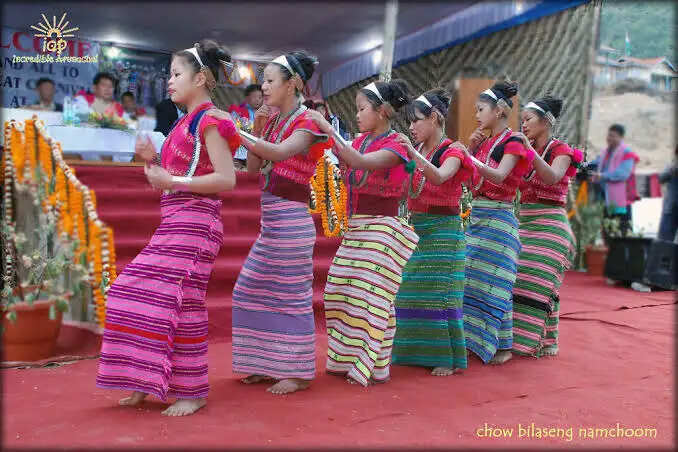Read About The Folk Dances Of Arunachal Pradesh

Buiya Dance:
Originating from the Digaru Mishmi tribe, Buiya dance is a communal celebration performed by both men and women. Typically held after feasts or family gatherings, this lively dance fosters unity within the community. It is also a staple in festivals like Tazampu, Duiya, and Tanuya.

During the performance, the dancers, accompanied by drum and gong beats, move effortlessly from the front to the rear of the passage. The dance involves simple yet rhythmic steps, including a unique skipping movement performed with grace by women and energetic jumps by men.
There is no specific dress code for Buiya dance; participants usually wear traditional tribal attire.
Chalo Dance:
Part of the Chalo Loku festival in Arunachal Pradesh, Chalo dance is a Nocte tribe celebration before the paddy harvest season. Dancers, adorned in traditional attire, perform at the chief's courtyard.
Men wear loincloths and elaborate headgear with white feathers, while women don blouses, cotton skirts, and matching waistcloths. Metallic jewelry, armlets, anklets, and earpieces complete their attire.
Synced with drum beats, Chalo dance involves both singing and dancing, creating a vibrant and cultural spectacle.
Wancho Dance:
Central to the Oriah festival of the Wancho tribe, Wancho dance promotes solidarity among tribe members. Traditional attire is a must, with men wearing loincloths, cane bands, and distinct headgear adorned with hornbill feathers.
Male dancers carry a basket with jingling bells, producing music as they move. Women wear blouses, skirts, and colorful accessories.
The dance alternates between men and women, with men wielding swords and performing unique thrusting movements. Men move in rounds, while women form two straight lines facing each other.
Pasi Kongki:
A celebration of the Adi tribe, Pasi Kongki is a unique folk dance portraying the social work of the Pasi. The dance narrates their journey to procure iron and transform it into sharp knives.
Both men and women perform, with men wearing white shirts, loincloths, and jackets, along with distinctive headgear. Women dress in blouses, ankle-length skirts, and conical hats.
The dance involves energetic movements to the rhythm of the drum, with men carrying swords. It pays tribute to those who risked their lives for the tribe.
Ponung Dance:
Belonging to the Adi tribe, Ponung Dance is a religious celebration performed by young girls and women in a circle. The Miri, the sole male participant, sings folk songs and plays the Yoksha instrument.
Women wear traditional attire—black shirts, wrapped skirts, and conical hats adorned with jewelry. Long chains and neckpieces complete their look.
Simple dance steps accompany the rhythmic circle formation, and the performance revolves around themes like the origin of crops and Adi history.
Popir Dance:
Associated with the Galo tribe, Popir Dance is performed by female members during the Mopi festival. It pays tribute to the Goddess Mopin Ape, the deity of prosperity and fertility.
Dancers wear pure white blouses, wrap skirts with red or maroon thread work, and bamboo accessories. The dance involves elegant foot movements, forming chains, and holding equipment in repetitive steps.
Bardo Chham:
Translated as 'Dance of the Zodiacs,' Bardo Chham is a significant dance of the Sherdukpens community. It depicts the fight against twelve evils, symbolizing the victory of good over evil.
Both men and women perform, wearing vibrant costumes and masks representing animal forms. Elaborate headgear and rhythmic movements convey the narrative.
Large drums and cymbals provide crucial music accompaniment during this captivating performance.

